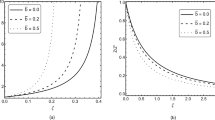Abstract
Newtonian spherically symmetric transonic accretion is studied by including the mass of the accreting matter, while considering the growth of the accretor itself to be negligibly small. A novel iterative method is introduced to accomplish that task. It is demonstrated that the inclusion of the mass of the fluid changes the critical properties of the flow as well as the topological phase portraits of the stationary integral solution. The changes are small in the framework of this methodology. It is shown that to get large changes one has to develop a new method.
























Similar content being viewed by others
Notes
In this paper, the basic fluid equations are taken from this cited book.
References
Bondi, H.: Mon. Not. R. Astron. Soc. 112 (1952)
Chia, T.T.: Mon. Not. R. Astron. Soc. 185 (1978)
Clarke, C.J., Carswell, R.F.: Principle of Astrophysical Fluid Dynamics. Cambridge University Press, Cambridge (2007)
Demircan, O., Kahraman, G.: Astrophys. Space Sci. 181 (1991)
Griffiths, D.J.: Introduction to Quantum Mechanics, 2nd edn. p. 356. Pearson Education, Upper Saddle River (2004)
Hartle, J.B.: Gravity an Introduction to Einstein’s General Relativity. Pearson Education, Upper Saddle River (2013)
Mullan, D.J.: Physics of the Sun a First Course p. 5. CRC Press/Taylor and Francis Group, Boca Raton/London/New York (2010)
Spitzer, L. Jr.: Physical Processes in the Interstellar Medium. VCH, Weinheim (2004)
Stix, M.: The Sun an Introduction p. 16. Springer, Berlin (1991). Corrected second print
Acknowledgements
The author is thankful to his Ph.D. supervisor for introducing him to this problem and for his help in modifying the calculations and the overall presentation. He is thankful to his colleague Dhruv Pathak for useful discussions. The author is also thankful to referee for going through his manuscript very carefully and for suggesting several important modifications.
Author information
Authors and Affiliations
Corresponding author
Appendix A
Appendix A
For adiabatic flow the changes in the critical parameters are found to be small in the frame of method of iteration. Mathematically
Now using expression \(\lambda_{b}^{2}=z_{b}^{(\gamma+1)}x^{4}\) in Sect. 3,
Multiplying the above expression by 100,
This the relation among the percentage change in critical parameters. Rearranging,
In the range of \(\gamma\) (1.33 to 1.66), \(g\) is always greater than \(f\). Numerical results show that \(g\) is also greater than \(h\). Numerical results show that \(f\) does not depend on \(\gamma\) and \(h\) decreases with \(\gamma\) and from the above expressions, \(g\) decreases with \(\gamma\).
Similarly for isothermal flow using \(\lambda_{b}=x_{b}^{2}z_{b}\),
Our previous analysis shows that \(f\) is negligibly small, so
Rights and permissions
About this article
Cite this article
Datta, S. Bondi flow revisited. Astrophys Space Sci 361, 260 (2016). https://doi.org/10.1007/s10509-016-2849-2
Received:
Accepted:
Published:
DOI: https://doi.org/10.1007/s10509-016-2849-2




